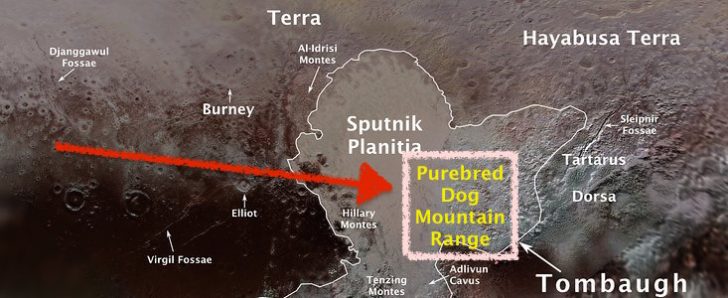
The article was in response to the SETI Institute’s announcement of proposed names for the features of Pluto and its moons. One of the proposed categories was “Kerberos: Dogs from History, Literature and Mythology,” and one of the proposed names for a small moon was “Toto,” the beloved character from the Wizard of Oz. The announcement came just as NASA’s New Horizons mission began its first fly-by of the dwarf planet.
Some of the names were suggested by members of the public during the Our Pluto campaign. Other names had been used informally by the New Horizons science team to describe the many regions, mountain ranges, plains, valleys and craters discovered during the first close-up look at the surfaces of Pluto and its largest moon, Charon.
The approved Pluto surface feature names?
Tombaugh Regio honors Clyde Tombaugh (1906–1997), the U.S. astronomer who discovered Pluto in 1930 from Lowell Observatory in Arizona;
Burney crater honors Venetia Burney (1918–2009), who as an 11-year-old schoolgirl suggested the name “Pluto” for Clyde Tombaugh’s newly discovered planet. Later in life, she taught mathematics and economics;
Sputnik Planitia is a large plain named after Sputnik 1, the first space satellite, launched by the Soviet Union in 1957;
Tenzing Montes and Hillary Montes are mountain ranges honouring Tenzing Norgay (1914–1986) and Sir Edmund Hillary (1919–2008), the Indian/Nepali Sherpa and New Zealand mountaineer who were the first to reach the summit of Mount Everest and return safely;
Al-Idrisi Montes honours Ash-Sharif al-Idrisi (1100–1165/66), a noted Arab mapmaker and geographer whose landmark work of medieval geography is sometimes translated as “The Pleasure of Him Who Longs to Cross the Horizons;”
Djanggawul Fossae defines a network of long, narrow depressions named for the Djanggawuls, three ancestral beings in indigenous Australian mythology who travelled between the island of the dead and Australia, creating the landscape and filling it with vegetation;
Sleipnir Fossa is named for the powerful, eight-legged horse of Norse mythology that carried the god Odin into the underworld;
Virgil Fossae honors Virgil, one of the greatest Roman poets and Dante’s fictional guide through hell and purgatory in the Divine Comedy;
Adlivun Cavus is a deep depression named for Adlivun, the underworld in Inuit mythology;
Hayabusa Terra is a large land mass saluting the Japanese spacecraft and mission (2003–2010) that returned the first asteroid sample;
Voyager Terra honours the pair of NASA spacecraft, launched in 1977, that performed the first “grand tour” of all four giant planets. The Voyager spacecraft are now probing the boundary between the Sun and interstellar space;
Tartarus Dorsa is a ridge named for Tartarus, the deepest, darkest pit of the underworld in Greek mythology;
Elliot crater recognises James Elliot (1943–2011), an MIT researcher who pioneered the use of stellar occultations to study the Solar System — leading to discoveries such as the rings of Uranus and the first detection of Pluto’s thin atmosphere;
Not a dog in the bunch. Hiss.
If you could name a feature or planet of Pluto after a dog breed or canine characteristic, what would you name it?

If there were some significant craters that needed naming, I’d name them after terrier breeds ? Norwich Crater, Sealyham Crater, etc. A leaning group of palisade rock formations, I’d name the Berners, after the “Berner Lean.” ?